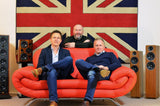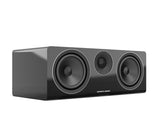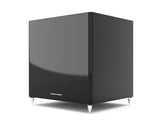Opera Loudspeakers Callas
Opera Loudspeakers

The Company

Opera Loudspeakers was founded in 1989, but its origins go back to the early 1980s, to an unusual but highly fruitful synergy between two cultures and two audiophiles, one Italian and the other English. The first loudspeaker to bear the Opera name was called Caruso, and was the precursor of a series named in homage to the legendary voices of the lyric opera. Callas, Operetta and Divina soon followed, each gaining enthusiastic acclaim in the developed audio markets of the world. Opera loudspeakers immediately appeared as a fusion between the old and the new: between traditional Italian craftsmanship in cabinet-making and the most advanced acoustic technology. Every Opera loudspeaker, even the least expensive model, follows a tried and tested philosophy of design: the use of top quality materials allied to carefully applied basic principles of acoustic science. Today our loudspeakers are exported everywhere, from Europe to the Far East with relevant space on the most important hi-fi magazines.
Our intent is to create a complete line of high quality , beautiful to see and to listen to; we then developed over therefore also a line of accessories with the same principle that gave prestige to our speakers.
Gianni Maria Sacchetti, founder
Opera Callas Loudspeaker
With the new Callas Series , Opera wants to transfer the pleasure of listening to music inside the domestic walls recreating a three-dimensional sound stage, focused and stable , with the correct timbre , dynamic , detail and absence of listening fatigue .
To achieve this, each element of the project has been subjected to careful listening tests.
The new Callas speakers use techniques and components that represent the state of the art in electroacoustic, starting from the cabinet., the speakers and the crossovers. The result is tonally correct, realistic , engaging, and above all enjoyable to listen to.
The new model Callas is an example of elegance and fits discreetly into any environment .
Callas 2014 is a compact two-way loudspeaker (14 litres) of medium-small size which can be placed on a shelf or a stand . Its main feature is the low-frequency response, extended and controlled, combined with a typical sensitivity of froorstanding speakers. The woofer is a 7-inches, "long-throw", with annealed polypropylene diaphragm combined with the Scanspeak 9700 tweeter (the same used for Tebaldi, Malibran, Caruso and the new Grand Callas 2014) . The woofer is reflex loaded with a rear duct .
Great care has been placed in the elimination of the internal reflections to ensure maximum transparency in the voice reproduction.
Callas 2014 is equipped with a switch that allows you to adjust the output of the vocal range (+2 dB between 300 and 3000 Hz). This increases greatly the flexibility of the diffuser that fits both to a greater number of environmental situations .
The new Callas produces a sound stage that expands in three dimensions with an excellent impulse response and power , dynamics and extension at low frequencies typical of systems of much higher dimensions . This speaker is also suitable for the "near field" listening (up to one meter to the listening point).
The Loudspeakers
The woofers is made by Seas on Opera specifications . It is an 7" woofer with re-cooked polypropylene cone and rubber rim with copper ring above and bellow the T-shaped pole piece and 12 mm pk-pk displacement. ( a Seas technology named Excel ). This component , although used with a cutoff at 2000 Hz is able to work perfectly up to 5000 Hz . This guarantees a perfect overlap between the woofer and tweeter two octaves before and beyond the cutoff frequency . With musical program the Callas con easily produce more tham 100 SPL in the listener position with very low distortion.
The diaphragm of the midrange is made with re-coked polypropylene (annealed) . The polypropylene has a good internal damping but a low stiffness. Subjecting it to an heat stress it acquires rigidity without losing too much internal damping . The annealing, however, is a delicate process ..
The Scanspeak 9700 tweeter needs no introduction: it is one of the best tweeters ever made and , in some respects , is still unsurpassed . Currently, this tweeter is used on models Malibran , Caruso, Tebaldi , Callas Grand , 2014, Callas in 2014 and also on the new Opera Quinta 2014. Besides the quality of sound, this tweeter is also highly reliable.
The cabinet
The Callas is small-medium sized speaker. The internal volume is 14 liters dedicated to he woofer. The cabinet is made from MDF and veneered curved plywood. The thickness ranging from 25 mm (sides) to 50 mm of the front panel. The front panel on the inner side, in correspondence of the holes of the woofer, is milled so that turbulence does not arise in the vicinity of the speaker membranes.
Internal sides are non parallel. One of the problems of the speakers are the resonances of the cabinet and the other is internal reflections. Regarding the rigidity this is guaranteed by the thickness and the weight of the walls. In order to reduce internal reflections behind the woofers there are two layers of absorbent material with pyramidal profile for a total thickness of 20 centimeters.
The absorbing material is an open cell polyurethane foam with pyramidal profile (with base 7 x 7 cm , 3 cm and 7 cm for the basic height of the pyramid ). This porous material , with its particular profile , provides an absorbing coefficient of 60% at 250 Hz and reaches almost 100% at 500 Hz. Strategically placing the right amount of this absorbent material inside the cabinet befall both reflections ( which would produce masking ) and the normal modes of the cavity which would produce annoying noise.
Probably you expect to see all the inner surfaces of the cabinet covered with absorbing material. Inside the Callas model the absorbing material operates according to the principle of the "acoustic trap" killing the reflections inside the cabinet and reproducing a mid range of very high quality.
The ratio between the moving mass of the woofer diaphragm and the mass of the cabinet is well above 1 to 1000. That means that only a negligible part of the energy due to the motion of the speakers is transferred to the cabinet by promoting the " horizontal definition " or, as is often said, an articulate bass.
The cross-over filter
The Callas Cross-over has a low-pass section of the second order for the woofer and a high-pass section of the second order for the tweeter. These section are completely separated and is possible to bi-amp the diffuser.
We recall that , once set the crossover frequency to f, the electrical phase changes over a decade before and a decade after the cut-off frequency . With a cross-over frequency at 2000 Hz this is a problem for the tweeter. This is why we choose only tweeter with a very wide frequency response and a wide linear displacement. And this is also why we use second order high-pass section.
To build the cross-over we use high quality components such as Mundorf capacitors, MOX resistors and OFC , autocementing, inductors. The PCB is carefully drown to avoid self induction between the windings that interfere on distortion and clarity.
Room Positioning
The sound quality produced by a pair of loudspeakers depends on a series of details: for example, orienting the speakers towards the listening point you can adjust the depth of the sound stage. You can choose, subjectively, to make the speakers "cross over" in front of the listener, on the head of the listener, or behind the listener's head.
The Callas model has a switch that regulates the level of the vocal frequency range so you can choose the switch position that seem subjectively better. The two speakers must be regulated in the same way.
When there are many listeners you may need to use two pairs if diffuser arranged and connected as shown. As the Grand Callas has a nominal impedance of 4 ohms they must be connected in series.
42 x 24.5 x 42 cm (HxWxD)
Weight:15 Kg each
System:two-way stand or shelf, Reflex with rear duct
Finishes:Walnut, Mahogany
1 7 "Seas woofer in annealed polypropylene
1 1" Scanspeak 9700 tweeter
2
Frequency response:40-25000 Hz
Cross-over:2000 Hz approx
Woofer: low pass at 12 dB / oct;
Tweeter: high pass at 12 db octave;
100 watts RMS Watts with music program
with a crest factor greater than 5
starting from 10 Watt
Sensitivity89 dB / 2.83 Volt / 1 meter
Nominal Impedance4 ohm (Zmin> 3 ohm)
at least 5 cm from the back wall,
distance between the speakers from 1.5 to 3 meters,
oriented towards the listening point














